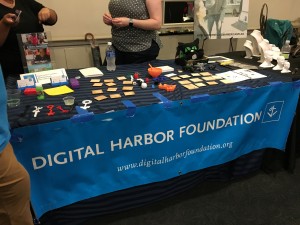This past week, the Institute of Museum and Library Services hosted The Capitol Hill Maker Faire as a part of the White House’s National Week of Making. The STEM Challenge attended the Faire to network with other organizations and spaces that are also devoted to making and innovation.

The Faire explored the best practices and challenges of the maker community, in order to foster educators’ and community leaders’ efforts to further innovation across the country. The organizations represented at the Faire varied greatly—from libraries with tech programs to Girl Scouts displaying robots their troops made. The event featured both panel discussions and an opportunity for participants to showcase their work in booths.
One relevant panel discussion, entitled Making and Lifelong Learning, focused on the informal maker space. Panelists included Janet Auer of Chevron, Andrea Saenz of the Chicago Public Library, Janella Watson of the New York Hall of Science, and Shawn Grimes of the Digital Harbor Foundation. They discussed the big trends in the evolution of these community spaces, the importance of designing inclusive maker spaces, and the barriers to expanding the impact and sustainability of these programs.
The maker space is unique. It is a space that allows for users to be messy and creative — without the pressures and restrictions of school or work. Maker spaces are open workshops with equipment for users to create something. They range from fully equipped wood working shops to tech spaces with 3-D printers and computers.

The panelists advised that maker space creators should consider allowing users access to the space without specific guidelines or restrictions—let the space respond to the makers who use it. The focus should be mostly on fostering creativity and passion for making, and not on the space itself. Also, a collaborative process should be used to design the space in the first place, so that users will best utilize the space.
A specific concern that was raised was the issue of inclusivity. Panelists discussed how to make spaces feel accessible and welcoming for the elderly, for underprivileged students, and others. Speakers stressed the importance of considering how maker spaces brand themselves, to think about the invitation they’re extending—and to whom.
In order to maintain and build these spaces, it is important to demonstrate how these open spaces with resources help users innovate, and what maker space opportunities do for students and community members alike. The National STEM Video Game Challenge has hosted workshops in these maker spaces, like the TechShop in Pittsburgh. We have seen firsthand the benefits of supporting community spaces designed for people to innovate.
 Sloane Grinspoon is an intern at the Cooney Center this summer, working with the National STEM Video Game Challenge team. She studies Psychology at Cornell University.
Sloane Grinspoon is an intern at the Cooney Center this summer, working with the National STEM Video Game Challenge team. She studies Psychology at Cornell University.


